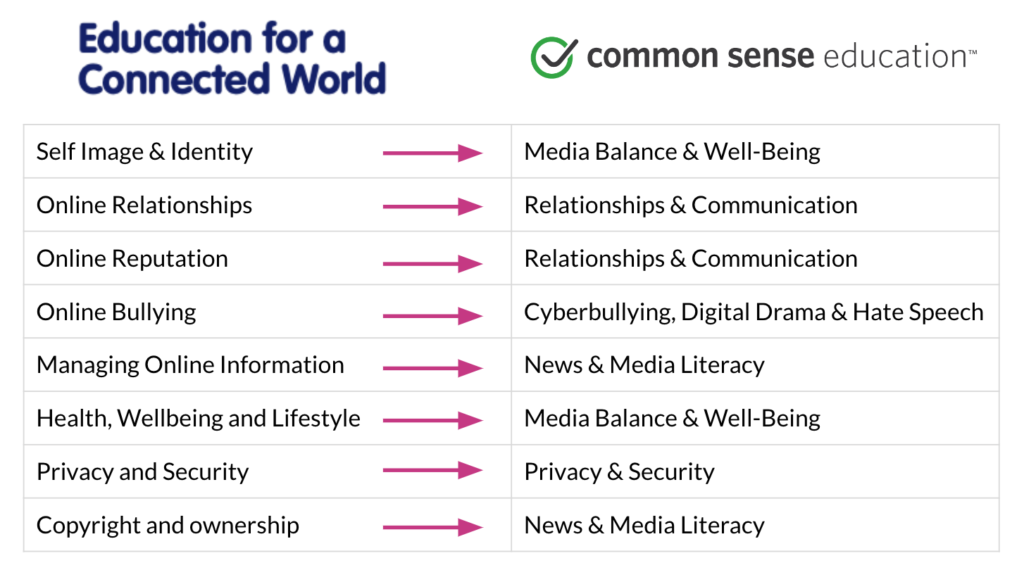Digital Literacy and Online Safety (Year 6)
National Curriculum Links - Computing KS2
The content of this plan cover the following NC strands:
- use search technologies effectively, appreciate how results are selected and ranked, and be discerning in evaluating digital content
- select, use and combine a variety of software (including internet services) on a range of digital devices to design and create a range of programs, systems and content that accomplish given goals, including collecting, analysing, evaluating and presenting data and information
- use technology safely, respectfully and responsibly; recognise acceptable/unacceptable behaviour; identify a range of ways to report concerns about content and contact.
Why this? What does it build on?
This unit builds on important online safety messages from Key stage 1 (Keeping safe and exploring technology and Keep safe and create) and more recently, our Digital Literacy and Online Safety units for Year 3, Year 4 and Year 5. In those units, students learn about screen time issues, privacy, digital footprints, online communities, online bullying, copyright principles, our responsibilities to others online, passwords, their own online identities, media choices and fake imagery.
Communication and collaboration and Computational thinking - Alien contact both also have elements of online safety in their lessons and cover communicating safely with others online, and safety when using social media.
Having this broad knowledge of digital literacy and online safety issues is vital for young people to grow up to be confident and responsible users of technology and digital citizens in our world.
What comes next?
The digital literacy content in this unit will be built upon in Key Stage 3. We also offer Common Sense Education units of work for Digital Literacy and Online Safety for Year 7 and Year 8.
Other Year 6 units also include online safety and digital literacy messages, such Manipulating images and Inside the internet.
View our full curriculum map
Take a look at our full curriculum map to see how units across all year groups, from Year 1 to Year 6 link.
Unit Resources
Key vocabulary for this unit
Advertising - messages or photos that are made to persuade someone to buy a certain product
Article - A written story in a newspaper, magazine, or online news site
Avatar - An image or character that represents a person online
Balance - All of the parts are in the correct -- though not necessarily equal -- proportions
Benefit - Something positive that results from a situation
Bias - An unfair belief about a person or group based on a stereotype
Bully - The person who is doing the bullying
Bullying - Unwanted and aggressive verbal, social, or physical behaviour towards another
Bystander - Someone who sees a bullying or cyberbullying situation, but doesn't do anything to stop it
Clickbait - An image or headline that tries to get you to click on it, usually for advertising purposes
Commercial - Intended to make money.
Curiosity Gap - The desire people have to figure out missing information
Cyberbullying - using digital devices, sites, and apps to intimidate, harm, and upset someone
Digital media - information that comes to us through the internet, often through a tablet, smartphone, or laptop
Empathy - To imagine the feelings that someone else is experiencing
Gender stereotypes - Oversimplified ideas about how women and men are or should be
Headline - The title of an article, usually printed in big, bold letters at the top
Inference - an educated guess based on evidence
Media - all of the ways that large groups of people get and share information (TV, books, internet, newspapers, phones, etc).
Media balance - using media in a way that feels healthy and in balance with other life activities (family, friends, school, hobbies, etc).
Media choices - time spent watching, listening to, reading, or creating media.
News - New information about recent or important events
Personal information - information about you that cannot be used to identify you because it is also true for many other people (e.g. your hair colour or the city you live in)
Private information - information about you that can be used to identify you because it is unique to you (e.g. your full name or your address)
Risk - Something negative or dangerous that could come from a situation
Target - The person who is on the receiving end of the bullying
Upstander - a person who supports and stands up for someone else
Related units
Digital Literacy and Online Safety (Year 8)
About this unit Six lessons taken from Common Sense Education’s excellent digital citizenship curriculum, covering a wide range of topics…
Digital Literacy and Online Safety (Year 7)
About this unit Six lessons taken from Common Sense Education’s excellent digital citizenship curriculum, covering a wide range of topics…
Digital Literacy and Online Safety (Year 6)
About this unit: Six lessons taken from Common Sense Education’s excellent digital citizenship curriculum, covering a wide range of topics…
Digital Literacy and Online Safety (Year 5)
About this unit: Six lessons taken from Common Sense Education’s excellent digital citizenship curriculum, covering a wide range of topics…
Digital Literacy and Online Safety (Year 4)
About this unit: Six lessons taken from Common Sense Education’s excellent digital citizenship curriculum, covering a wide range of topics…
Keeping Safe and Exploring Technology
You need to be logged in to view this content. Please Log In. Not a Member? Join Us

